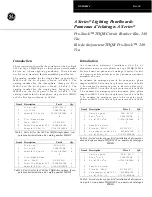
54
PrimeGear ZX0
P R O D U C T M A N U A L
4.1.3 Operation of the three position
disconnector
Depending on the version of the switchgear
system, the three position disconnector can be
operated remotely (from the control room) or
locally. At the panel, the three position
disconnector operating mechanism can be
operated manually, or electrically if a motor and
electrical controls (e.g. the human-machine
interface of a control device) are fitted.
4.1.3.1 Operation of the three position
disconnector (manual mechanism)
Turning the selector lever (4) moves a sliding
cover to release the opening (5 or 7) for the
operating lever of the disconnector or earthing
switch. The operating lever for the earthing
switch (Fig.4.1.3.1.1) has a hexagon socket and is
marked red, and the operating lever for the
disconnector (Fig.4.1.3.1.2) has a splined socket
and is marked black.
The selector lever can only be turned when the
circuit breaker is switched off. Turning the
selector lever in the direction for earthing switch
operation is only possible when the disconnector
is switched off, and turning in the direction for
disconnector operation is only possible when the
earthing switch is switched off.
—
Fig. 4.1.3.1.1
Operating lever with
hexagon and red
handle for operation
of the earthing
switch
—
Fig. 4.1.3.1.2
Operating lever with
splines and black
handle for operation
of the disconnector
•
The selector lever can be blocked by a padlock.
To fit the padlock, press the selector lever
towards the cover.
•
Mechanical switch position indication is
effected by graphical symbols (6 and 8) in the
drive compartment cover.
Always perform all switching operations
up to the stop.
If the stop is not reached by the manual
switching motion, it is possible to remove the
operating lever but the selector lever is not
returned to its vertical initial position and the
relevant opening (5 or 7) is not closed off. The
circuit breaker is blocked.
•
When the operating lever is turned, increased
force can be felt after approx. 25°, and this has to
be overcome to reach the limit position (stop).
—
Fig. 4.1.3.1.1
—
Fig. 4.1.3.1.2















































